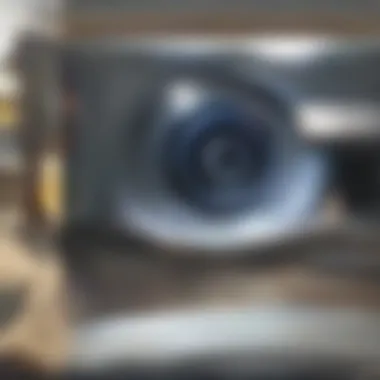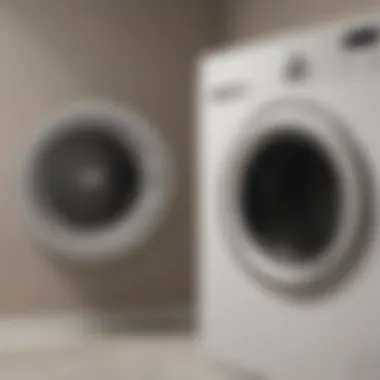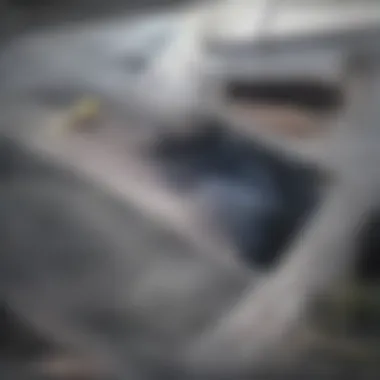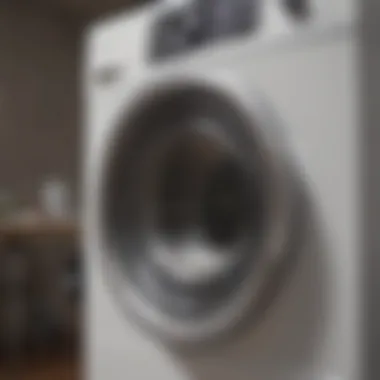Essential Guide to Dryer Vent Cleaning Techniques


Intro
Maintaining a clean dryer vent is crucial for safety and efficiency in the home. Each year, thousands of house fires start due to lint buildup in dryer vents. This significant risk underscores the importance of routine cleaning. Homeowners often overlook this task, yet it is not only vital for preventing fire hazards but also essential for enhancing the overall performance of the dryer.
In this guide, we will explore the best methods for cleaning dryer vents. We will cover the tools you need, detailed procedures to follow, and when it might be time to hire a professional. By understanding and implementing these practices, homeowners can ensure their dryers operate at optimal efficiency while minimizing potential hazards.
Understanding Dryer Vent Cleaning
Cleaning your dryer vent is a task that often goes unnoticed until problems arise. However, understanding its significance is vital for both safety and efficiency in any home. A clean dryer vent can greatly improve the performance of your dryer, enhance its lifespan, and minimize any fire hazards that may result from lint build-up.
The Importance of Regular Dryer Vent Maintenance
Regular maintenance of dryer vents is essential. The lint that accumulates in these ducts can obstruct airflow, leading to longer drying times and increased energy consumption. When the vent is clear, the dryer can operate effectively, consuming less energy and resulting in lower utility bills. Moreover, routine cleaning is a proactive approach to avoid potential fire hazards. According to the National Fire Protection Association (NFPA), failure to clean dryer vents is the leading cause of dryer-related fires. Thus, making vent cleaning a regular part of home maintenance is not just beneficial; it is necessary for safety.
Consequences of Neglected Dryer Vents
Neglecting dryer vent cleaning can lead to several problems. One of the most immediate consequences is reduced efficiency. When lint builds up, it restricts airflow, causing the dryer to work harder than it should. This added strain can dramatically increase wear and tear on the appliance, leading to costly repairs or even premature replacement. Additionally, the risk of fire becomes significantly higher. Each year, thousands of home fires are attributed to clogged dryer vents. Besides safety issues, the impact on energy costs is another consequence. An inefficient dryer consumes more energy, which leads to higher bills. Regular maintenance of dryer vents mitigates these risks and maintains the appliance’s effectiveness.
Indicators That Your Dryer Vent Needs Cleaning
Understanding the indicators that your dryer vent needs cleaning is crucial for maintaining your equipment's efficiency and safety. Recognizing these warning signs allows homeowners to act promptly, thus preventing potential hazards such as fire risks or increased energy consumption. Ignoring signs of blockage can lead to costly repairs or replacements. Awareness of these indicators ensures the proper functioning of your dryer, and helps in prolonging its lifespan.
Signs of Lint Build-Up
One of the most telling signs that your dryer vent requires cleaning is the accumulation of lint. Lint collects not just in the lint trap but also in the vent itself. This can obstruct airflow, limiting the dryer’s effectiveness. If you notice significant amounts of lint backing up in the screen despite cleaning it frequently, this is an urgent signal. Additionally, if you see lint around the dryer area or inside the vent hood, this indicates that lint is escaping the dryer system and must be addressed promptly.
Increased Drying Times
Longer drying times can be another key indicator of a clogged dryer vent. If your clothes are consistently taking longer to dry than usual, it may signal that the vent is blocked. Normally, clothes should dry in about 30 to 40 minutes, but if it takes much longer, the vent may not be allowing adequate airflow. This not only frustrates users but also leads to unnecessary energy costs. Hence, it is advisable to look into the dryer vent system at the first sign of increased drying times.
Burning Smell During Operation
Experiencing a burning smell while the dryer is in use should be taken very seriously. This unpleasant odor may arise from overheating due to lint buildup obstructing proper airflow. A burning smell can also occur if the dryer is working excessively hard to circulate hot air. This situation potentially risks the safety of your home, as restricted airflow can generate heat high enough to ignite lint. If a burning smell occurs, the dryer should be turned off immediately and unplugged for safety until you are able to clean the vent or arrange for professional help.
Recognizing the signs that indicate your dryer vent needs cleaning is essential for preventing fire hazards and enhancing your dryer’s efficiency.
Essential Tools for Dryer Vent Cleaning
Cleaning your dryer vent is a crucial task that requires the right tools. Using appropriate equipment not only makes the job easier but also maximizes its effectiveness. Here, we will discuss three essential tools that help ensure a thorough cleaning of your dryer vent.
Lint Trap Brush
A lint trap brush is a basic yet important tool for dryer vent cleaning. This brush is designed specifically to remove lint build-up in your dryer’s lint trap. Having a clean lint trap is essential in ensuring that the dryer operates efficiently.
Benefits of Using a Lint Trap Brush:
- Prevention of Fire Hazards: Lint accumulation can lead to blockages, increasing the risk of fire. Keeping the lint trap clean reduces this risk significantly.
- Improved Drying Efficiency: A cleaner lint trap will allow air to flow freely, reducing drying times and energy consumption.
- Easy to Use: These brushes come in various sizes and are easy to handle, making it a simple task for any homeowner.
Vacuum with a Hose Attachment
A vacuum with a hose attachment is another essential tool for dryer vent cleaning. This tool helps reach deep within the vent ducts where lint may have accumulated. The vacuuming process removes lint that a brush may not fully extract, ensuring a more thorough clean.
Considerations for Using a Vacuum:
- Ensure Adequate Suction Power: A vacuum should have good suction capabilities to effectively eliminate stubborn lint.
- Hose Length and Flexibility: The hose needs to be long enough to reach all areas of the ductwork and flexible enough to navigate turns and corners.
- Cleaning After Each Dry Cycle: Regularly using a vacuum helps maintain vent cleanliness and prevents the build-up of lint.


Flexible Dryer Vent Cleaning Brush
A flexible dryer vent cleaning brush is specialized equipment designed for the intricate shapes of dryer vent systems. Its flexibility allows it to navigate bends and curves effectively, accessing areas that are typically hard to reach.
Advantages of Using a Flexible Brush:
- Thorough Cleaning: It ensures that every inch of the vent is cleaned, reducing the risk of lint build-up.
- Versatile Use: This brush can also be used on various vent types, making it a valuable tool for homeowners with different appliances.
- Time and Effort Save: A flexible brush can make the cleaning process quicker, requiring less effort than rigid alternatives.
Using these tools together can vastly improve the safety and efficiency of your dryer vent, making maintenance tasks more manageable.
Step-by-Step Guide to Cleaning Your Dryer Vent
Cleaning your dryer vent is a crucial maintenance task that can enhance the efficiency and longevity of your dryer. Proper cleaning prevents lint build-up, which is a common cause of appliance malfunction and fire hazards. Completing this step-by-step guide will ensure you do not overlook any important process involved in maintaining your dryer vent.
Preparing for Cleaning
Before you start the cleaning, gather all necessary tools. You will need a lint trap brush, a vacuum cleaner with a hose attachment, a flexible dryer vent cleaning brush, and possibly a screwdriver depending on your dryer model.
In addition to tools, make sure you have a clear workspace. Moving any items around the dryer can help avoid accidents. It is also advisable to wear gloves and a mask to limit exposure to dust and allergens that may arise during cleaning.
Disconnecting the Dryer
The first step involves safely disconnecting the dryer from power. Unplug the appliance from the wall outlet. For gas dryers, turn off the gas supply as an additional safety measure. Make sure the dryer is completely offline before proceeding.
Accessing the Vent
Next, move the dryer away from the wall to gain access to the vent. Check how the vent is connected: some configurations may require you to unscrew vents from the back of the dryer. Detach any clamps or screws carefully, ensuring you do not damage the dryer or vent system.
Cleaning the Vent Interior
Once you have access to the dryer vent, use the flexible dryer vent cleaning brush to remove lint and debris from the interior. Insert the brush into the vent and rotate it as you pull it back out. Doing this regularly is essential for effective cleaning. For deeper cleaning, utilize the vacuum with the hose attachment to remove loose debris.
Even if your vent appears clear, run the vacuum along the length of the vent to ensure no lint remains trapped. This is vital in preventing potential hazards.
Reassembling and Testing the Dryer
After cleaning, it is important to reassemble any parts you removed earlier. Tighten screws and re-attach clamps to ensure everything is secure. Once you have reconnected the dryer, plug it back into the power source or turn the gas supply back on.
To test if the cleaning was effective, run a short drying cycle with some old towels. Monitor the operation while checking for abnormal sounds or smells. If the dryer works properly without any issues, you have successfully completed your dryer vent cleaning.
Regular maintenance of your dryer vent not only improves efficiency but also safeguards your home against fire hazards.
Maintaining an organized approach while following these steps to clean your dryer vent will yield safer and more effective appliance operation.
Best Practices for Dryer Vent Maintenance
Maintaining a dryer vent is essential for not only the appliance's optimal performance but also for the safety of your home. Regular upkeep can prevent fire hazards, reduce energy costs, and prolong the lifespan of your dryer. Each of the practices outlined below plays a significant role in responsible dryer vent management.
Regular Inspection Schedule
Establishing a regular inspection schedule for your dryer vent is crucial. It is advisable to check the vent at least once a year for any lint build-up or potential blockages. Homeowners should also monitor the vent more frequently during heavy usage periods, such as after long laundry days. Observing the conditions of the vent can reveal early signs of issues that might require attention. Simple checks may include:
- Visual inspection: Look for any visible lint buildup around the vent exit.
- Feel for airflow: When the dryer is running, you should feel a steady airflow at the vent's exit.
- Check for moisture: Any dampness or excessive heat around the vent indicates a blockage.
Integrating these inspections into your routine ensures that you catch potential hazards early, maintaining a safe household environment.


Using Proper Materials
The materials used in your dryer vent system can greatly affect its efficiency and safety. It is important to choose high-quality, durable materials that are resistant to lint accumulation and heat. Here are some considerations:
- Vent ducting: Always opt for semi-rigid or rigid metal ducting instead of fragile plastic or vinyl. Metal ducts handle heat better and are less likely to become dislodged.
- Clamps and connectors: Ensure all connections are tight and secure to prevent gaps where lint might escape or accumulate. Using clamps made of metal can prevent these issues.
- Vent covers: Install proper vent covers that can open when the dryer is in use and close when not. This not only keeps the vent free from debris but also prevents backdraft.
Using the right materials can lead to fewer maintenance issues and a more efficient dryer.
Educating Household Members
Educational efforts should not be overlooked when it comes to dryer vent maintenance. Each member of the household plays a role in ensuring the dryer operates both safely and effectively. Here are several points to consider:
- Understanding usage: Inform all household members about the proper settings to use on the dryer. Knowing the appropriate cycles can minimize wear and tear on the appliance.
- Lint removal: Create a habit of cleaning the lint trap before or after every load. Explain why this is important and how it prevents fire hazards.
- Recognizing issues: Teach everyone the signs of potential dryer vent problems, such as increased drying times or unusual smells.
Educating each individual ensures that the entire household is engaged in maintaining the dryer vent, leading to a safer and more efficient environment.
When to Seek Professional Help
Cleaning your dryer vent is a critical maintenance task that can affect the safety and efficiency of your appliance. However, there are instances where DIY cleaning is not enough. Knowing when to seek professional help ensures that the job is done thoroughly and safely. It protects your home from potential hazards associated with clogged vents.
Indicators for Professional Cleaning
Several specific indicators suggest that it is time to bring in the professionals for dryer vent cleaning. These include:
- Heavy Lint Accumulation: If you notice significant buildup of lint beyond what you can reach during routine cleaning, this is a sign that professional tools and expertise may be required.
- Repeated Operational Issues: When your dryer continues to show problems, such as insufficient drying cycles or overheating, a professional can provide a thorough inspection that you might miss.
- Age of the Venting System: If your dryer vent is old or made from materials prone to clogging, like flexible plastic, you may benefit from a professional's assessment to determine if replacement or specialized cleaning is needed.
In many homes, lint buildup isn't just a nuisance; it can easily lead to a fire hazard. Professionals are equipped to handle severe cases that can pose risks beyond standard cleaning capabilities.
Choosing a Reputable Service Provider
Once you decide that professional assistance is necessary, selecting the right service provider is crucial. Here are key factors to consider:
- Credentials and Experience: Ensure the company has appropriate certification, and check reviews or references from past clients. This gives insight into their reputation.
- Services Offered: Some companies may provide additional services like inspecting the entire dryer system or replacing any damaged components. Consider this if you need more than just cleaning.
- Pricing Transparency: A reputable company should provide clear pricing structures without hidden fees. Get an estimate before the work starts to avoid unexpected charges.
- Insurance Coverage: Make sure the service provider is insured. This protects you in cases of accidents or damages during the cleaning process.
Proper dryer vent cleaning can significantly reduce risks associated with fire hazards and improve appliance efficiency.
Engaging professionals ensures that your dryer vent remains in good condition, thus prolonging the life of the appliance and enhancing safety at home. In the long term, investing in professional cleaning can save money and help avoid serious issues.
Cost Considerations for Dryer Vent Cleaning
Understanding the costs associated with dryer vent cleaning is critical for homeowners. Proper maintenance of your dryer vent can significantly influence the appliance's efficiency and safety. The expenses involved come in two forms: DIY costs and professional service charges. By evaluating these options, you can make an informed decision that balances budget constraints with the need for a thorough cleaning.
Average Costs for DIY Vs. Professional Services
Cleaning your dryer vent can be done either as a DIY project or through professional services. The cost will vary based on the approach.
DIY Costs:
- Lint Trap Brush: Typically costs between $10 to $30. This simple tool is used for cleaning the lint trap and the vent exit.
- Vacuum with Hose Attachment: A vacuum with specialized attachments can set you back $50 to $150, depending on the model.
- Flexible Dryer Vent Cleaning Brush: Priced around $15 to $25, this brush reaches deep into the duct, removing trapped lint.
So, if a homeowner decides to handle the cleaning themselves, total costs could range from about $75 to $200.
Professional Services:
- Most professional cleaning services range from $100 to $300, depending on the complexity of the job and the condition of the dryer vent system. This cost often includes inspection and thorough cleaning of the vent.
- Some factors affecting price might be the location of the vent, the length of the ductwork, or if there are any difficult access points involved.


In general, while the upfront cost for professional help can be higher, it often translates to a more exhaustive cleaning, which might not be achievable via DIY methods.
Cost-Benefit Analysis of Regular Cleaning
Investing in regular dryer vent cleaning can yield significant financial benefits over time.
- Reduction in Energy Costs: A clean dryer vent allows the dryer to operate efficiently. When lint builds up, it restricts airflow, causing the machine to work harder. This leads to higher energy consumption and can increase your utility bills.
- Decreased Fire Hazards: Lint accumulation is a major fire risk. Regular cleaning can prevent clogs and reduce the probability of a dryer-related fire. In the event of a fire, the cost of damages can be catastrophic and far exceed any expenses incurred from routine maintenance.
- Longer Appliance Lifespan: A well-maintained dryer is less likely to malfunction. Regular cleaning can help extend the life of the dryer, delaying the need for costly repairs or replacements.
- Time Savings: When a dryer operates efficiently, it not only saves energy but also significantly reduces drying time. This can lead to less time spent on laundry tasks.
- Tip: Reducing drying time by just a few minutes can noticeably lower your monthly energy bill.
"Lint accumulation is cited as the leading cause of dryer fires, leading to thousands of injuries and millions in property losses each year."
- Consider this an investment in the longevity of your appliance.
- Regular maintenance can relieve you of the frustration of frequent breakdowns.
Environmental Impact of Dryer Vent Cleaning
Understanding the environmental impact of dryer vent cleaning is crucial not only for homeowners but also for society at large. When dryer vents are not properly maintained, several issues arise which can affect energy consumption, create hazardous conditions, and contribute to environmental degradation. As we explore the significance of dryer vent cleaning, we will focus on two main areas: reducing energy consumption and minimizing fire hazards.
Reducing Energy Consumption
Cleaning your dryer vent has a direct impact on energy efficiency. When the vent becomes clogged with lint and debris, the dryer works harder to expel the hot air necessary for drying clothes. This inefficiency leads to increased energy usage, which can be costly. By regularly cleaning out the vent, homeowners can ensure that their dryers operate at optimal efficiency.
- Lower energy bills: Regular maintenance reduces the workload on your dryer, resulting in lower utility costs.
- Extended appliance lifespan: An efficiently working dryer is less likely to suffer from wear and tear, potentially increasing its lifespan.
- Eco-conscious choice: Using less energy contributes to a lower carbon footprint, which is beneficial for the environment.
To illustrate, a dryer that takes longer to dry clothes typically consumes more electricity than one that is well-maintained. By investing a bit of time into cleaning, you create not only a more efficient appliance, but also help in conserving natural resources.
Minimizing Fire Hazards
One of the lesser-discussed yet critical reasons for maintaining dryer vents is fire safety. Clogged vents can lead to dangerous conditions that may ignite a fire. Lint, which is highly flammable, can accumulate in the vent and pose a significant risk.
"Neglecting dryer vent maintenance can increase the potential for residential fires, making it a safety issue for all homes."
- Fire statistics: According to the National Fire Prevention Association, nearly 16,000 home fires occur annually due to clothing dryers, primarily because of improper venting.
- Safety practices: Regularly checking for lint build-up can drastically reduce these risks and ensure that your home is safe.
- Peace of mind: Knowing that your dryer is operating correctly and safely allows for worry-free use of the appliance.
Minimizing fire hazards is crucial for protecting both property and lives. Thus, focusing efforts on cleaning dryer vents serves a greater purpose than just appliance maintenance; it plays a significant role in safeguarding homes.
Culmination: Prioritizing Dryer Vent Maintenance
Maintaining your dryer vent should not be an afterthought. It is an essential part of ensuring the safety and efficiency of your dryer. Regular cleaning of the dryer vent directly impacts the machine's performance. This task can lead to significant cost savings on energy bills and possibly extend the lifespan of the appliance itself. Notably, by investing the time and effort into proper dryer vent maintenance, you also minimize the risk of fire hazards that can occur from lint build-up.
Individuals might underestimate the impact a clean vent has on drying efficiency. When the vents are clogged, the dryer must work harder to expel moisture. This extra strain can lead to overheating, which is a common cause of dryer fires. The repercussions can be severe, affecting not only the appliance but also household safety, thus making preventative measures critical. An annual check-up, at minimum, is a proactive approach to reducing risks.
To sum up, prioritizing dryer vent cleaning is not merely a suggestion; it's a necessity. Here are key benefits to keep in mind:
- Increased Efficiency: A clean vent ensures that clothes dry faster, using less energy.
- Cost Savings: Reduces energy consumption leading to lower utility bills.
- Enhanced Safety: Clean vents help avoid dangerous fire hazards.
- Longer Appliance Life: Maintaining the dryer leads to better durability, saving you replacement costs.
Overall, with the right tools, knowledge, and regular maintenance, homeowners can take significant steps towards ensuring the effectiveness of their dryer systems. With this knowledge, it's clear that dryer vent maintenance deserves a top spot on your home maintenance checklist.
Final Thoughts on Safety and Efficiency
In concluding, safety and efficiency are intertwined when it comes to dryer vent maintenance. Addressing these aspects leads to a more comfortable home environment and peace of mind. Ignoring this crucial maintenance not only leads to inefficiencies in drying laundry but also creates unsafe conditions. Acquiring a simple set of cleaning tools can empower any homeowner to take this task into their own hands.
It is often more economical to maintain your dryer than to allow problems to escalate due to neglect. Regular checks and timely cleanings can prevent minor issues from developing into major repairs. Investing in your dryer vent cleanliness means investing in your home safety and efficiency.
“Take charge of your dryer’s efficiency today to enjoy a safer and cost-effective tomorrow.”
In a world increasingly mindful of energy consumption and safety standards, it is prudent to stay informed and proactive. Arm yourself with knowledge and make dryer vent maintenance a priority. Proper care today leads to safety and efficiency in the long run.







